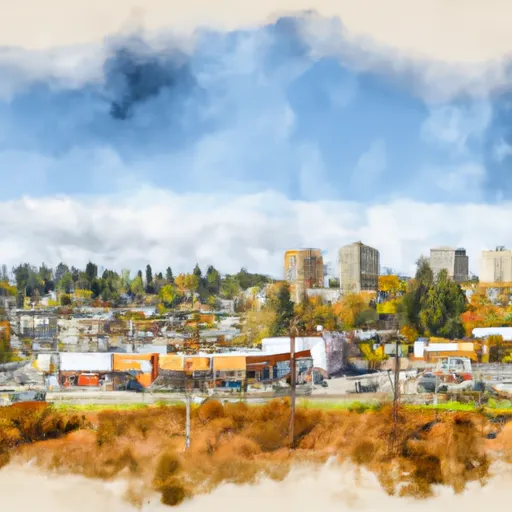-
 Snoflo Premium
Snoflo Premium
Get unlimited access to all our content
With no Ad interruptions! - Start Your Free Trial Login with existing account
Woodway
Eden Index
Climate
8.3
•
Recreation
3.1
•
Community
4.7
•
Safeguard
5.6/10

Woodway is a small town located in Snohomish County, Washington. It experiences a mild, marine-influenced climate with cool, wet winters and warm, dry summers. The average annual precipitation is around 40 inches, which ensures the area stays lush and green throughout the year. The climate is ideal for outdoor enthusiasts seeking year-round recreational activities.
Woodway is blessed with a diverse hydrology system, including several creeks and a shoreline on the Puget Sound. The main hydrological constituents in the area are the Perrinville and Shell Creeks, which flow through the town and provide crucial habitat for various wildlife species. The Puget Sound shoreline offers opportunities for fishing, boating, and beachcombing.
Outdoor recreation opportunities in Woodway are abundant. The town is home to numerous parks and trails, providing opportunities for hiking, biking, and wildlife observation. Woodway Park, located on the eastern edge, features over 40 acres of forested land with nature trails and access to the beach. Additionally, nearby Olympic National Park and Mount Baker-Snoqualmie National Forest provide ample opportunities for camping, hiking, and skiing. With its favorable climate, beautiful hydrology constituents, and diverse outdoor recreational opportunities, Woodway is a haven for nature lovers.
What is the Eden Index?
The Snoflo Eden Index serves as a comprehensive rating system for regions, evaluating their desirability through a holistic assessment of climate health, outdoor recreation opportunities, and natural disaster risk, acknowledging the profound impact of these factors on livability and well-being.
Climate Health Indicator (CHI): 8.3
Woodway receives approximately
992mm of rain per year,
with humidity levels near 82%
and air temperatures averaging around
11°C.
Woodway has a plant hardyness factor of
8, meaning
plants and agriculture in this region tend to thrive here all year round.
By considering the ideal temperature range, reliable water supplies, clean air, and stable seasonal rain or snowpacks, the Climate Health Indicator (CHI) underscores the significance of a healthy climate as the foundation for quality living.
A healthy climate is paramount for ensuring a high quality of life and livability in a region, fostering both physical well-being and environmental harmony. This can be characterized by ideal temperatures, reliable access to water supplies, clean air, and consistent seasonal rain or snowpacks.
Weather Forecast
Streamflow Conditions
Puget Sound
Area Rivers
Puget Sound
Snowpack Depths
Puget Sound
Reservoir Storage Capacity
Puget Sound
Groundwater Levels
Recreational Opportunity Index (ROI): 3.1
The Recreational Opportunity Index (ROI) recognizes the value of outdoor recreational options, such as parks, hiking trails, camping sites, and fishing spots, while acknowledging that climate plays a pivotal role in ensuring the comfort and consistency of these experiences.
Access to outdoor recreational opportunities, encompassing activities such as parks, hiking, camping, and fishing, is crucial for overall well-being, and the climate plays a pivotal role in enabling and enhancing these experiences, ensuring that individuals can engage in nature-based activities comfortably and consistently.
Camping Areas
| Campground | Campsites | Reservations | Toilets | Showers | Elevation |
|---|---|---|---|---|---|
| Camano Island State Park | 88 | 181 ft | |||
| Manchester State Park | 35 | 27 ft | |||
| Fay Bainbridge State Park | 65 | 15 ft | |||
| Kayak Point Regional Park | None | 8 ft | |||
| Wenberg County Park | 75 | 408 ft |
Nearby Fishing
Nearby Ski Areas
Catastrophe Safeguard Index (CSI):
The Catastrophe Safeguard Index (CSI) recognizes that natural disaster risk, encompassing floods, fires, hurricanes, and tornadoes, can drastically affect safety and the overall appeal of an area.
The level of natural disaster risk in a region significantly affects safety and the overall livability, with climate change amplifying these risks by potentially increasing the frequency and intensity of events like floods, fires, hurricanes, and tornadoes, thereby posing substantial challenges to community resilience and well-being.
Community Resilience Indicator (CRI): 4.7
The Community Resilience Indicator (CRI) recognizes that education, healthcare, and socioeconomics are crucial to the well-being of a region. The CRI acknowledges the profound impact of these elements on residents' overall quality of life. By evaluating educational resources, healthcare accessibility, and economic inclusivity, the index captures the essential aspects that contribute to a thriving community, fostering resident satisfaction, equity, and social cohesion.

